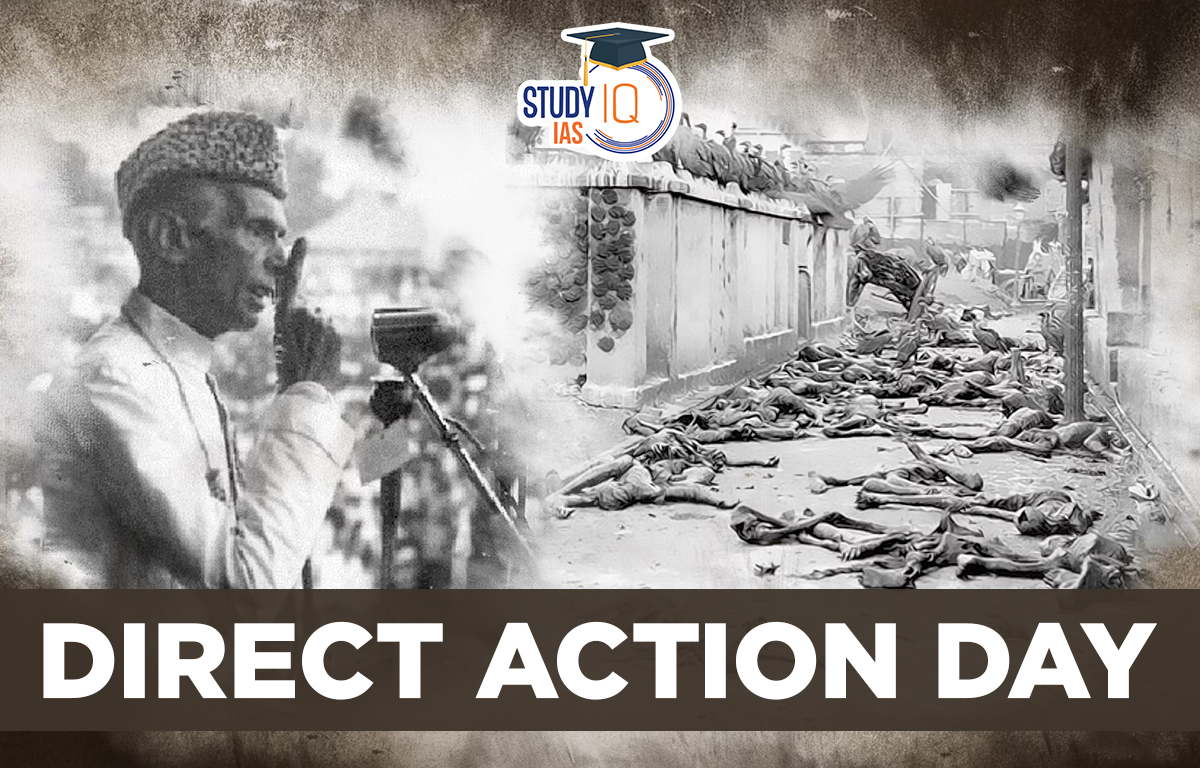Table of Contents
Direct Action Day
The “Great Calcutta Massacre” was scheduled for August 16, 1946, the Direct Action Day. This day marked the beginning of the “Week of Long Knives,” during which 6,000 Hindus and Muslims were shot, slashed, and otherwise brutalised. 200000 people were raped and injured. India hadn’t yet experienced freedom. R.L. Walker served as Bengal’s Chief Secretary. The Muslim League’s Huseyn Shaheed Suhrawardy served as Bengal’s prime minister.
Suhrawardy asked Bengal’s governor, Sir Frederick Burrows, to enact a vacation on August 16. The Bengal Congress, however, objected to the public holiday’s proclamation because it would allow Muslims to impose hartals. This piece contains all the information you need to know about Direct Action Day for UPSC Exam preparation.
Read about: Interim Government
Direct Action Day History
The conflict between India and the British Raj had hit a turning point when British Prime Minister Clement Attlee sent a three-person Cabinet Mission to India in 1946. In order to award India independence and Dominion status in the Commonwealth of Nations, the mission’s objective was to discuss and complete plans for the transfer of power from the British Raj to the Indian leadership.
The Mission presented its early proposals for the structure of the new Dominion of India and its government on May 16, 1946, following discussions with representatives of the Indian National Congress and the All India Muslim League. With representatives of the Indian National Congress and the All India Muslim League, the Mission discussed initial proposals for the structure of the future Dominion of India and its administration.
The Mission put forth an alternative proposal to split India into Pakistan, which has a majority of Muslims, and India, which has a majority of Hindus, in response to criticism from Jinnah’s Muslim League. It would be possible for India’s princely states to remain autonomous or join the dominions. The Muslim League’s head, Jinnah, a former congressman and Indian nationalist, agreed to the Cabinet Mission Plan of June 6. Later on June 24, Lawmakers approved the mission’s recommendations.
Jawaharlal Nehru said in a news conference on July 10 that Congress had only committed to participating in the Constituent Assembly and that it saw itself as free to change or modify the Cabinet Mission Plan as it saw appropriate. In order to put pressure on Congress and the British through “Direct Action,” Jinnah chose to abstain from the Constituent Assembly out of concern for Hindu dominance in the body.
In July 1946, Jinnah declared his plan to found Pakistan at a press conference. He vowed to take “direct action” if the Muslims were denied Pakistan. In order to create a separate Muslim state, Jinnah proclaimed August 16, 1946, to be “Direct Action Day.”
Read about: Indian National Army
Direct Action Day and Events Associated
In order to resolve the dispute between the Indian National Congress (INC) and the Muslim League regarding independence, the British government dispatched the Cabinet Mission to India in 1946. In India’s Constituent Assembly, these two groups constituted the majority. The INC desired a united India, whereas the League wanted a separate homeland for the Muslims they called Pakistan.
Since the League and the Congress could not concur on the idea of a united India with a strong centre, the Mission failed. The Muslim League declared August 16th as Direct Action Day and called for a general hartal in response to the Mission’s failure to succeed, protesting the INC’s position and fiercely calling for a separate homeland.
At the period, Huseyn Shaheed Suhrawardy of the Muslim League served as Bengal’s Chief Minister. A large rally with Suhrawardy in charge was planned by the League. People would arrive in procession from various locations and assemble at the Ochterlony Monument to join the rally. Although there were reports of forced store closings, stabbings, and stonings as early as the morning, the demonstration didn’t begin until noon.
Read about: Tebhaga Movement
Direct Action Day Riot
The Muslim League’s founder, Muhammad Ali Jinnah, declared August 16, 1946, “Direct Action Day” and urged Muslims all over the world to “halt all trade.” This was done to put pressure on the British government to comply with the League’s demand that the country be divided along religious lines, thereby making it easier to create a Pakistan dominated by Muslims.
Read about: Communist Movement in India
Direct Action Day Outcome
At the rally, league leaders made ferocious speeches that enthralled the large audience. Large-scale violence in Calcutta followed this. On the first day, about 4000 individuals died. In the riots, there were murders, rapes, forcible conversions, and thefts. Suhrawardy is accused by many of inciting the populace to violence and then neglecting to stop it while serving as Chief Minister.
Some have also accused Sir Frederick John Burrows, the Governor of Bengal, of failing to manage the situation. Soon, this intergroup conflict spread to other regions of northern India, especially Bihar. Noakhali, which is now in Bangladesh, experienced horrific bloodshed. The Great Calcutta Killings are another name for the bloodshed that occurred on Direct Action Day and in the days that followed. Some of the locations witnessed rioting on a size that could be considered genocide.
Numerous riots, especially in eastern, northern, and north-west India, resulted in thousands of deaths or acts of torture, casting a shadow over India’s attainment of freedom. The first of such rioting before freedom occurred with the Calcutta killings. After much bloodshed and communal strife, the INC eventually agreed to divide the nation into two parts to quell the chaos and violence.
Read about: Hindustan Republican Association
Direct Action Day UPSC
On August 16, 1946, members of one group rounded up members of another group and murdered them in cold blood with swords, knives, cleavers, rifles, and metal rods. This event will always be known as the day when the most basic human instinct of violence first manifested. These sectarian riots rate among the most heinous acts of violence in India’s history, leaving thousands of people dead in their wake. For complete information about direct action day for UPSC Exam preparation, read the full article.
Read about: Vande Mataram Movement


 Revival of Machilipatnam Port in Andhra ...
Revival of Machilipatnam Port in Andhra ...
 Nagari Pracharini Sabha Revival: Backgro...
Nagari Pracharini Sabha Revival: Backgro...
 Ryotwari System in India, Features, Impa...
Ryotwari System in India, Features, Impa...





















